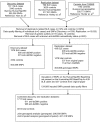Differential genetic associations for systemic lupus erythematosus based on anti-dsDNA autoantibody production
- PMID: 21408207
- PMCID: PMC3048371
- DOI: 10.1371/journal.pgen.1001323
Differential genetic associations for systemic lupus erythematosus based on anti-dsDNA autoantibody production
Abstract
Systemic lupus erythematosus (SLE) is a clinically heterogeneous, systemic autoimmune disease characterized by autoantibody formation. Previously published genome-wide association studies (GWAS) have investigated SLE as a single phenotype. Therefore, we conducted a GWAS to identify genetic factors associated with anti-dsDNA autoantibody production, a SLE-related autoantibody with diagnostic and clinical importance. Using two independent datasets, over 400,000 single nucleotide polymorphisms (SNPs) were studied in a total of 1,717 SLE cases and 4,813 healthy controls. Anti-dsDNA autoantibody positive (anti-dsDNA +, n = 811) and anti-dsDNA autoantibody negative (anti-dsDNA -, n = 906) SLE cases were compared to healthy controls and to each other to identify SNPs associated specifically with these SLE subtypes. SNPs in the previously identified SLE susceptibility loci STAT4, IRF5, ITGAM, and the major histocompatibility complex were strongly associated with anti-dsDNA + SLE. Far fewer and weaker associations were observed for anti-dsDNA - SLE. For example, rs7574865 in STAT4 had an OR for anti-dsDNA + SLE of 1.77 (95% CI 1.57-1.99, p = 2.0E-20) compared to an OR for anti-dsDNA - SLE of 1.26 (95% CI 1.12-1.41, p = 2.4E-04), with p(heterogeneity)<0.0005. SNPs in the SLE susceptibility loci BANK1, KIAA1542, and UBE2L3 showed evidence of association with anti-dsDNA + SLE and were not associated with anti-dsDNA - SLE. In conclusion, we identified differential genetic associations with SLE based on anti-dsDNA autoantibody production. Many previously identified SLE susceptibility loci may confer disease risk through their role in autoantibody production and be more accurately described as autoantibody propensity loci. Lack of strong SNP associations may suggest that other types of genetic variation or non-genetic factors such as environmental exposures have a greater impact on susceptibility to anti-dsDNA - SLE.
Conflict of interest statement
The authors have declared that no competing interests exist.
Figures
References
-
- Pisetsky D. Systemic Lupus Erythematosus: Epidemiology, Pathology, and Pathogenesis. In: Klippel J, editor. Primer of the Rheumatic Diseases. 12 ed. Atlanta: Arthritis Foundation; 2001.
-
- Arbuckle MR, McClain MT, Rubertone MV, Scofield RH, Dennis GJ, et al. Development of autoantibodies before the clinical onset of systemic lupus erythematosus. N Engl J Med. 2003;349:1526–1533. - PubMed
-
- Buyon J. Systemic Lupus Erythematosus: A. Clinical and Laboratory Features. In: Klippel J, editor. Primer on the Rheumatic Diseases. 13 ed. New York, NY: Springer; 2008. pp. 303–318.
-
- Isenberg DA, Manson JJ, Ehrenstein MR, Rahman A. Fifty years of anti-ds DNA antibodies: are we approaching journey's end? Rheumatology (Oxford) 2007;46:1052–1056. - PubMed
-
- Tan EM, Cohen AS, Fries JF, Masi AT, McShane DJ, et al. The 1982 revised criteria for the classification of systemic lupus erythematosus. Arthritis Rheum. 1982;25:1271–1277. - PubMed
Publication types
MeSH terms
Substances
Grants and funding
- N01 AI095386/AI/NIAID NIH HHS/United States
- N01 AR012256/AR/NIAMS NIH HHS/United States
- KL2 RR024130/RR/NCRR NIH HHS/United States
- K24 AR002213/AR/NIAMS NIH HHS/United States
- AR043815/AR/NIAMS NIH HHS/United States
- R01 HL054900/HL/NHLBI NIH HHS/United States
- M01-RR000056/RR/NCRR NIH HHS/United States
- AR052300/AR/NIAMS NIH HHS/United States
- RR024130/RR/NCRR NIH HHS/United States
- HL054900/HL/NHLBI NIH HHS/United States
- HL088648/HL/NHLBI NIH HHS/United States
- R01 AR052300/AR/NIAMS NIH HHS/United States
- AI024717/AI/NIAID NIH HHS/United States
- AR043727/AR/NIAMS NIH HHS/United States
- U54 RR020278/RR/NCRR NIH HHS/United States
- M01 RR-000052/RR/NCRR NIH HHS/United States
- R01 AR046588/AR/NIAMS NIH HHS/United States
- R01 AI063274/AI/NIAID NIH HHS/United States
- M01 RR000079/RR/NCRR NIH HHS/United States
- R01 AR057028/AR/NIAMS NIH HHS/United States
- AR043814/AR/NIAMS NIH HHS/United States
- P20 RR020143/RR/NCRR NIH HHS/United States
- AI068759/AI/NIAID NIH HHS/United States
- R56 AI063274/AI/NIAID NIH HHS/United States
- M01 RR000056/RR/NCRR NIH HHS/United States
- AR057028/AR/NIAMS NIH HHS/United States
- HL074165/HL/NHLBI NIH HHS/United States
- P30 AR053483/AR/NIAMS NIH HHS/United States
- AR044804/AR/NIAMS NIH HHS/United States
- AR042460/AR/NIAMS NIH HHS/United States
- RR020143/RR/NCRR NIH HHS/United States
- AR043247/AR/NIAMS NIH HHS/United States
- AR052125/AR/NIAMS NIH HHS/United States
- N01 AR062277/AR/NIAMS NIH HHS/United States
- R01 AR052125/AR/NIAMS NIH HHS/United States
- AI063274/AI/NIAID NIH HHS/United States
- RC1 AR058621/AR/NIAMS NIH HHS/United States
- R01 AR043814/AR/NIAMS NIH HHS/United States
- HL092397/HL/NHLBI NIH HHS/United States
- R37 AI024717/AI/NIAID NIH HHS/United States
- R01 AR042460/AR/NIAMS NIH HHS/United States
- M01 RR000052/RR/NCRR NIH HHS/United States
- R01 AI024717/AI/NIAID NIH HHS/United States
- R01 HL074165/HL/NHLBI NIH HHS/United States
- R01 AR043727/AR/NIAMS NIH HHS/United States
- R01 CA141700/CA/NCI NIH HHS/United States
- AR046588/AR/NIAMS NIH HHS/United States
- AR002213/AR/NIAMS NIH HHS/United States
- R01 HL088648/HL/NHLBI NIH HHS/United States
- R01 HL092397/HL/NHLBI NIH HHS/United States
- R01 AI068759/AI/NIAID NIH HHS/United States
- K24 AR002175/AR/NIAMS NIH HHS/United States
- M01 RR-000079/RR/NCRR NIH HHS/United States
- AR02175/AR/NIAMS NIH HHS/United States
LinkOut - more resources
Full Text Sources
Medical
Molecular Biology Databases
Research Materials
Miscellaneous



